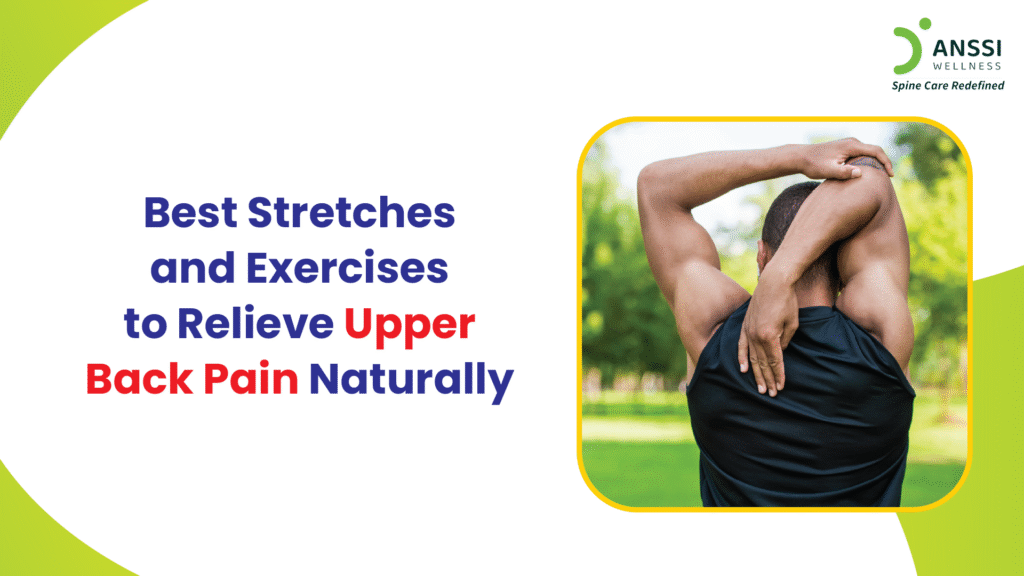Upper back pain is no longer an issue limited to aging adults; it is becoming increasingly common among young professionals, students, and even teenagers. Hours of sitting hunched over laptops, poor posture while using mobile phones, lack of physical activity, and stress all contribute to stiffness and discomfort in the upper back. While painkillers may provide temporary relief, they don’t address the root cause.
The good news? Natural methods like stretching and exercise can go a long way in easing pain and restoring flexibility.
Understanding Upper Back Pain
The upper back is supported by the thoracic part of your spine and is designed for stability and posture. However, prolonged sitting, weak muscles, poor posture, or repetitive strain can lead to stiffness, muscle imbalance, and discomfort. Common symptoms include tightness between the shoulder blades, restricted movement, and dull or sharp aches that worsen with inactivity.
Movement is medicine for the spine. Gentle stretches improve blood flow, loosen tight muscles, and reduce stiffness, while targeted exercises strengthen the supporting muscles to prevent future pain.
Best Stretches for Upper Back Pain Relief
Cat-Cow Stretch
This yoga-inspired stretch improves the spine’s range of motion and flexibility.
- Start on your hands and knees in a tabletop position.
- Take a deep breath, raise your head and tailbone, and arch your back (Cow Pose).
- Tuck your chin to your chest, round your back, and exhale (Cat Pose).
- Repeat 8-10 times, moving smoothly between the two poses.
Child’s Pose
A calming stretch that lengthens the spine and releases shoulder tension.
- Sit back on your heels while kneeling on the ground.
- Lower your torso and extend your arms forward.
- Hold the stretch for 20-30 seconds.
Thoracic Extension Stretch
Perfect for relieving stiffness in the mid-back.
- Put your hands behind your head while being seated in a chair.
- Lean back slowly, opening your chest and extending your upper back.
- Hold for 5-10 seconds, then return to neutral.
- Repeat 8-10 times.
Shoulder Rolls
Simple yet effective for releasing daily tension.
- Sit or stand upright.
- Roll your shoulders up, back, and down in a circular motion.
- Perform 10 rolls forward and 10 backward.
Best Exercises for Strength and Mobility
Wall Angels
This posture-correcting exercise strengthens upper back muscles.
- Place your feet a few inches forward and lean your back against a wall.
- Place arms against the wall in a goalpost position.
- Slowly slide arms upward and back down, maintaining contact with the wall.
- Perform 8-10 reps.
Resistance Band Pull-Aparts
A powerful exercise to build strength in the mid-back.
- Hold a resistance band at shoulder height with arms extended.
- Pull the band apart, squeezing shoulder blades together.
- Slowly return to the starting position.
- Repeat for 12-15 reps.
Seated Twist
Enhances spinal mobility and relieves tightness.
- Sit upright in a chair.
- Twist your torso slightly while placing your right hand on the chair’s back.
- Hold for 15-20 seconds, then switch sides.
Scapular Retractions
Strengthens stabilising muscles around the shoulder blades.
- Sit or stand upright with shoulders relaxed.
- Squeeze your shoulder blades together, hold for 3-5 seconds, then release.
- Perform 12-15 reps.
Lifestyle Tips for Long-Term Relief
While stretches and exercises help reduce immediate stiffness, adopting healthier lifestyle habits ensures long-term benefits. Here are some practical tips:
- Practise good posture: Keep your shoulders relaxed and back straight when working or sitting.
- Take regular breaks: Stand up, stretch, or walk for 2-3 minutes every hour.
- Set up an ergonomic workspace: Position your screen at eye level and use a chair that supports your back.
- Incorporate mindful breathing: Stress often tightens upper back muscles. Deep breathing reduces tension.
- Balance stretching with strengthening: Stronger muscles support better posture and prevent recurring pain.
About ANSSI:
ANSSI Wellness focuses on improving the quality of life for patients suffering from spinal issues, aiming to provide relief where other conventional treatments have failed. Through advanced Non-Surgical Spinal Decompression Treatment, ANSSI is committed to helping patients avoid surgery and recover in a safe, effective, and compassionate environment.
Connect with ANSSI Wellness on LinkedIn, Instagram, and Facebook for expert guidance.




